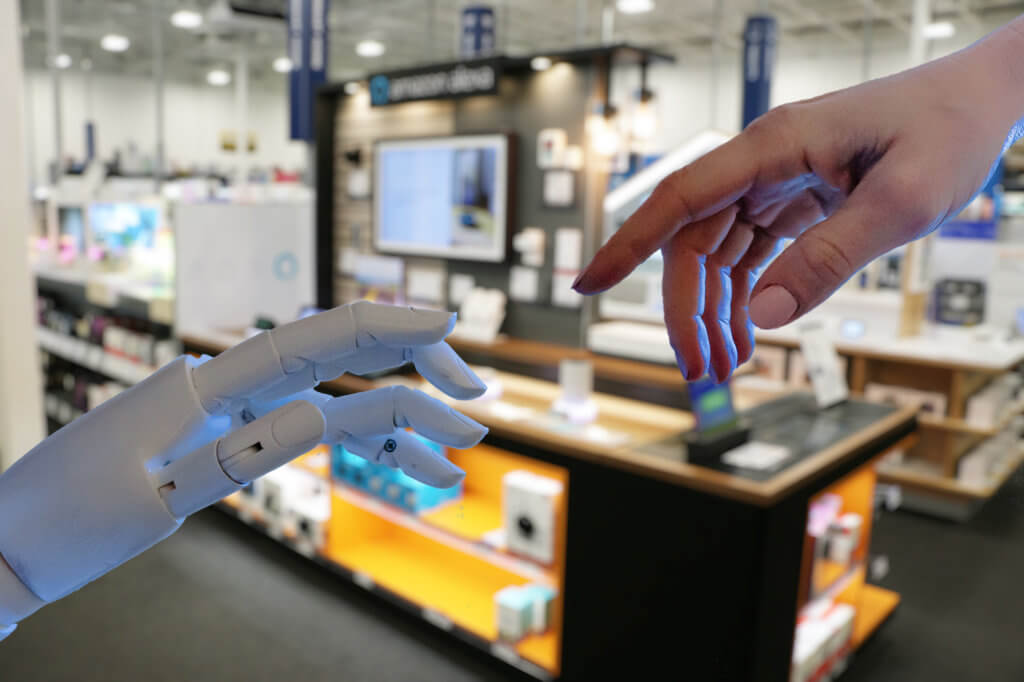
In 2020 alone, automated customer service increased by more than 140%. The pace of adoption in this space has grown over time as the digital transformation continues and more businesses seek out “smart” solutions. By 2023, the market for frictionless customer service tech in brick-and-mortar stores is even expected to balloon to $45 billion. Will the market find way to balance human customer service and automation?
Customers are similarly excited to use contactless customer service solutions. Surveys show that 66% of consumers prefer self-service technology if it means saving time. That said, the successful rollout of automated customer service solutions doesn’t mean that human representatives are becoming obsolete. According to reports, 55% of customers still prefer humans for customer service interactions. Considering that the efficacy of a business’s customer service influences up to 73% of customers –– and poor service costs companies up to $1.6 trillion annually — it may well be the case that most businesses will come out ahead choosing customer service that retains the human touch.
Why Customer Service Needs Human Intervention
For starters, automated customer service is not foolproof. Though AI and machine learning are designed to expand and fine-tune their services over time, they are inherently limited by the code they’re comprised of. In physical locations, this may cause some hiccups when the system is unable to understand or identify the consumer’s query. For instance, in scan-and-go checkouts, 67% of customers said they preferred this technology as it makes their experience richer, easier, and safer since they can just use their smartphones. However, for the 19% of customers who use cash or 15% who don’t have smartphones, they may not be able to optimize the services of a scan-and-go checkout. In such cases, a human cashier or representative would be better able to complete these transactions.
At the same time, although contactless solutions reduce human errors among staff, the tech does have a learning curve for customers. While self-service tech usually has an intuitive format and easy-to-understand instructions, for the elderly or disabled it may still prove difficult. Take virtual reality kiosks, for example. Though retail giants like Amazon are championing the technology as an immersive way that consumers can explore on their own, not everyone will know how to use the Oculus Touch hardware it comes with. Customers who aren’t tech-savvy may simply take their business elsewhere. However, if there’s a human representative available, customers can be taught how to use the tech. This way, they feel included and confident to try the technology again next time.
Although the whole point of automated customer service is to lighten the load on the human workforce, it’s not an entirely autonomous technology. The technology behind automated services, after all, is reliant on humans paving its path. Additionally, humans have the distinct advantage of real emotions and subtle nuance that can’t be taught to a machine or program. This is all particularly important in customer service, where very little is black and white.
How Technology and Human Representatives Can Work Together
So, how can humans work alongside technologies that are built to act independently? While some businesses may think that they have to choose between one or the other, it’s actually better to marry the two. This way, businesses — and consumers — can enjoy a holistic customer service approach.
Business-relevant programs
The first way that this can be accomplished is via specialized software solutions. Because customer service strategies aren’t one-size-fits-all, the demand for software developers to design bespoke and sensitive technology is increasing. This is a trend that is being pushed forward by educational institutions. new software graduates are taught a wide array of applications. Today’s software developers have to be experts in complex code, UI/UX design, and application execution, in order to help meet societal needs. This enables them to create personalized solutions for different brick-and-mortar environments. To illustrate, grocery store inventory is ever-moving, so software developers need to adjust self-service technologies to accommodate an auto-synced product catalog. In this way, product information is always updated, consumers can easily scan products without delay, and human sales representatives are free to handle more pressing cases.
In part because over 50% of retail decision-makers have expressed a desire to use more automated customer service, the U.S. Bureau of Labor Statistics expects to see 22% job growth among IT professionals in this field within the next seven years. With more designers, versatile and agile tech can be produced and adjusted in a more timely manner.
Complementary executions
Beyond the idea of humans influencing the development and application of AI programs, it is also important to consider the ways in which humans and automated systems can actively work together in stores that may not yet be optimized for self-service technology. In retail stores, an example of this is already being rolled out. By providing real-time information, sales representatives in retail stores can use digital displays to look up new products, stock updates, and current promotions. This can increase customer footfall and consumer conversions.
Another notable example of blended customer service reducing pain points can be seen among robot servers. In Japan, inclusive cafes have been utilizing robot servers to allow for better employment options for disabled waiters. In this way, customers can have their orders processed quickly, while disabled servers can safely control the robots from the comfort of their homes. Alternatively, robots are also making it easier for human representatives in retail centers like Walmart’s Sam’s Club. Here, robots scrub floors and scan inventory, thereby reducing the menial yet crucial tasks from the human workload.
In Conclusion
At the end of the day, there are merits to automated customer service that can save time, money, and energy for all involved. However, this area of service still requires the sensitivity and insights of humans. Rather than choosing to utilize one form of service or the other, it’s much wiser and more practical to invest in a blended version of modern customer service. Through cooperation rather than competition, human customer service and automation can create a well-rounded customer experience that will benefit any consumer-facing business.
Authored by Robbie Joyce
Article exclusively written for ascenticretail.com
